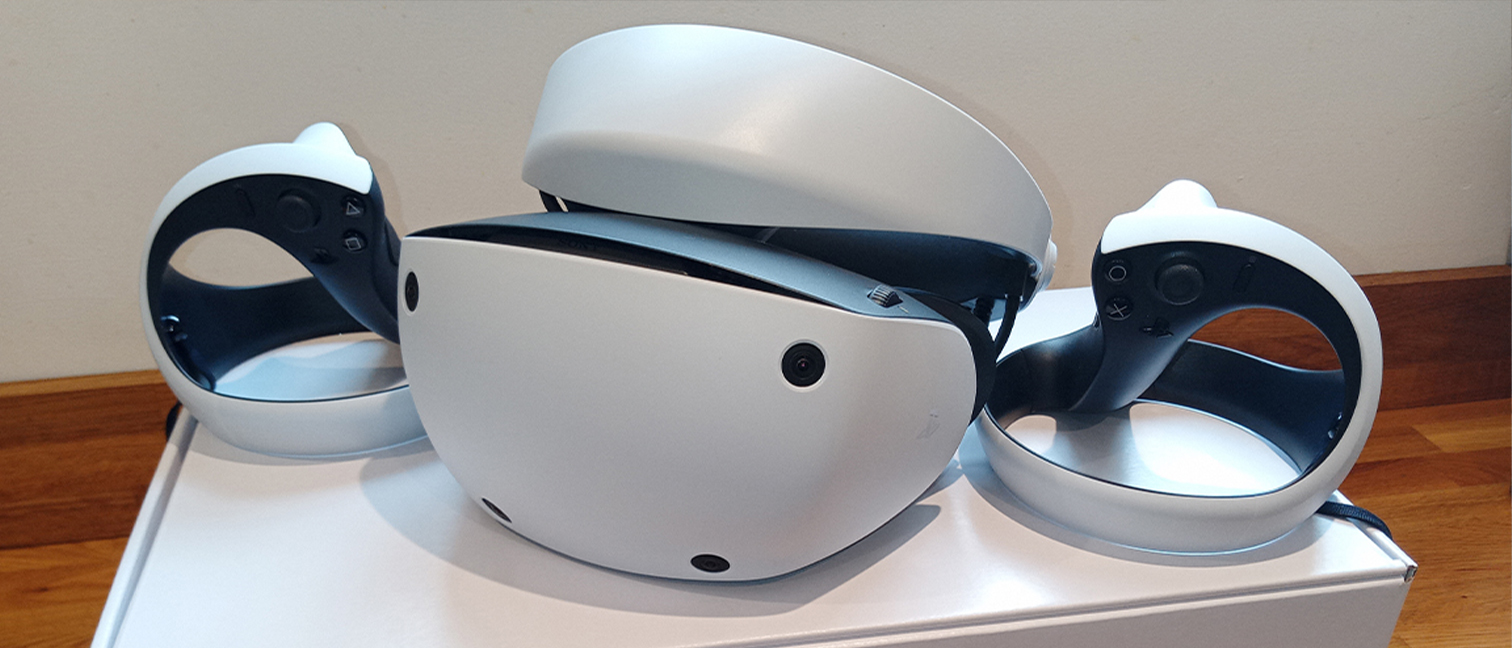Our Verdict
PSVR 2 is here and it's, honestly, a fantastic piece of technology. The design riffs on PS5's curves and this hardware design features the kind of approach to detail Sony has become renowned for; the curved lines demand you pick it up. Priced at $549.99 / £529.99, PlayStation VR2 is not cheap, but its worth the investment and represents a true next-gen approach to virtual reality.
For
- Wonderfully tactile design
- Packed with state-of-the-art tech
- Impressive launch games
Against
- Still some motion sickness
Why you can trust Creative Bloq
PSVR 2, or PlayStation VR2 to be formal, is the virtual reality headset Sony has been promising for years; while the original PSVR was a welcome and fun add-on for PS4 it never really became the VR platform it could have been, largely because PS4 was underpowered and PSVR relied on old motion sensor technology. By contrast, as my PSVR 2 review reveals, Sony's latest headset is a genuine next-gen powerhouse for virtual reality.
PSVR 2 costs $549.99 / £529.99 and you'll need a PlayStation 5 to power it – essentially this is an accessory for Sony's newest console – so that asking price doubles if you don't already own a PS5 (read my PS5 review to catch up on why this is a fantastic games console). Just like PS5 this new headset boasts a mix of cutting edge tech and proprietary hardware and firmware designed to eke out the maximum power and performance for VR; so is it worth the money?
That, and other questions, will be answered in this review. I'll primarily be focused on the hardware and how it performs, but I'll also take into account the launch game lineup as this can affect the value (it took PSVR a number of years to establish a good library of games and be usable, for example). It's one reason why reviewing PSVR 2 at launch and not before is a good test, as I can experience many of PlayStation VR2's games how they're meant to be played, with other people. Read our explainer 'How we test and review on Creative Bloq' for our process.
PSVR 2 review: in the box
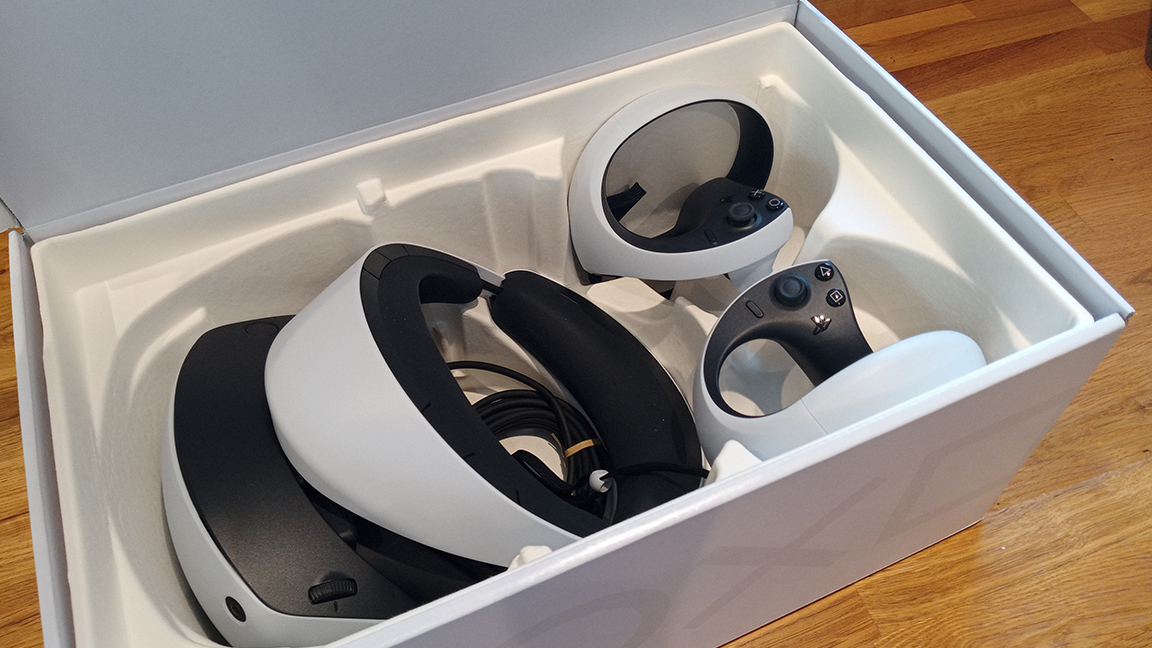
You know when great care and attention has been paid to product design when even opening the box is a joy, and offers a real world use. PSVR 2 comes in a small and neat box that when opened reveals moulded compartments for the headset and the two PlayStation VR2 Sense controllers, along with room for the earbuds, cable and instructions. It's such as well thought out idea and, as someone who had to stuff the original PSVR in a sports bag in a mangle of leads, this tidy approach is welcome. The box acts as a storage case, and it's a wonderful idea.
The PlayStation VR2 is actually quite compact. It has are two Sense controllers and with only one lead the whole thing can be boxed up easily. There are instructions in here too, which is welcome as many tech brands fail to package devices with setup instructions.
The earbuds need to be connected to the headset and the little bag they come in contains spare rubber buds too, which is useful as these often come loose and are lost or simply where out.
PSVR 2 review: setting up
Setting up PSVR 2 is easier than expected but more complex than the old PSVR system, largely because it uses more advanced tech such as eye-tracking. But the interactive guide is easily followed and makes your first venture into VR an easy one.
Some things I really like are the eye position guide; an on-screen icon displays a graphic of the headset and you're able to adjust your eye line to sit perfectly in the middle of the lenses – PSVR 2 has a fairly small 'box' to fit your eyes for perfect vision so it's worth taking this step seriously.
Another great feature of the setup is the new see-through mode that means you can see your surroundings inside the headset and then actively set your play area using the controllers to stretch and pinch a vector space to let PSVR 2 know where you are; it's also great to see my room mapped in vectors TRON-style as I glance around the room.
Real care has been taken by Sony to ensure your first steps in virtual reality are easy and approachable, it can take roughly ten minutes but it's better than the hit and miss approach of older VR systems.
PSVR 2 review: design
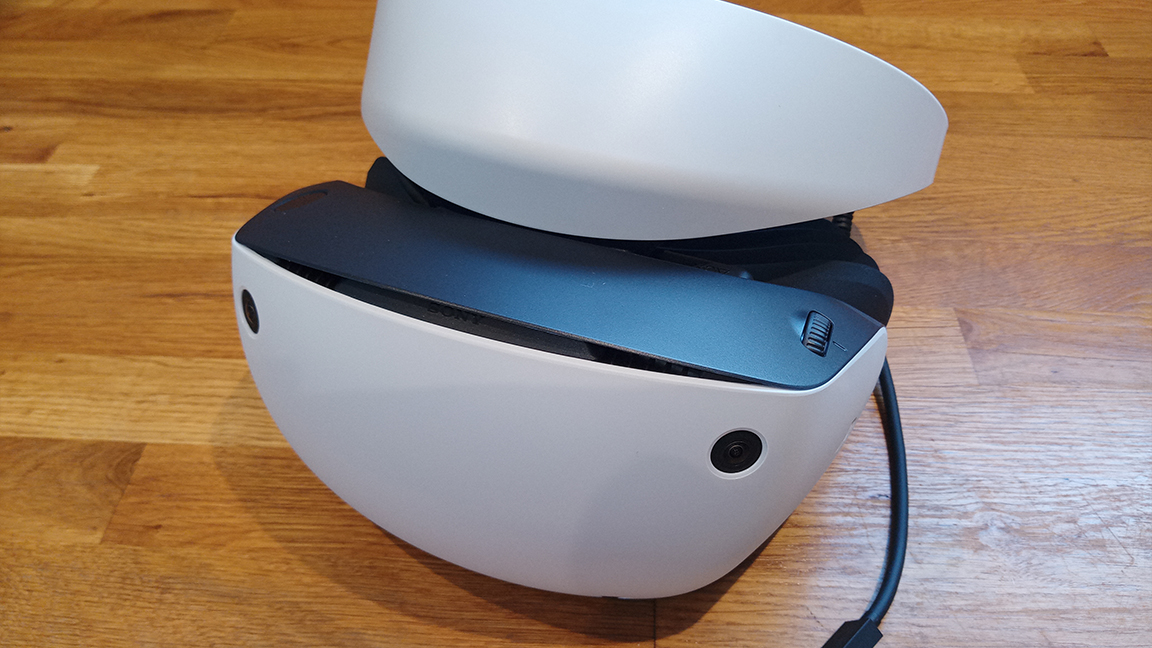
You can't escape the fact PSVR 2 is a hunk of plastic that sits on your head, but Sony has pulled out all of the stops to ensure its hunk of head-plastic is the best-looking, easiest to use, and most comfortable around.
The PSVR 2 looks beautiful and riffs on the design notes of the original PSVR while bending them around the look and feel of the PlayStation 5's curvatious form. The large middle band sits over your head and pulls snuggly behind too, while the front Scope that houses the lenses and hardware looks a little more industrial. PSVR 2 looks like nice balance between being a games 'toy' and a powerful piece of hardware.
Inside the headset is a concertina of black rubber that snuggly fits to the form of your face; unlike the original PSVR no light seeps in making this a fully immersive VR headset. This is not simply practical design either, the black rubber banding is detailed with incredibly tiny PlayStation symbols just like the curved shell of PlayStation 5. To the touch it offers a tactile surface but when you see the pattern of triangles, circles, squares and crosses it's another signal Sony has really taken some care over its product design and branding.
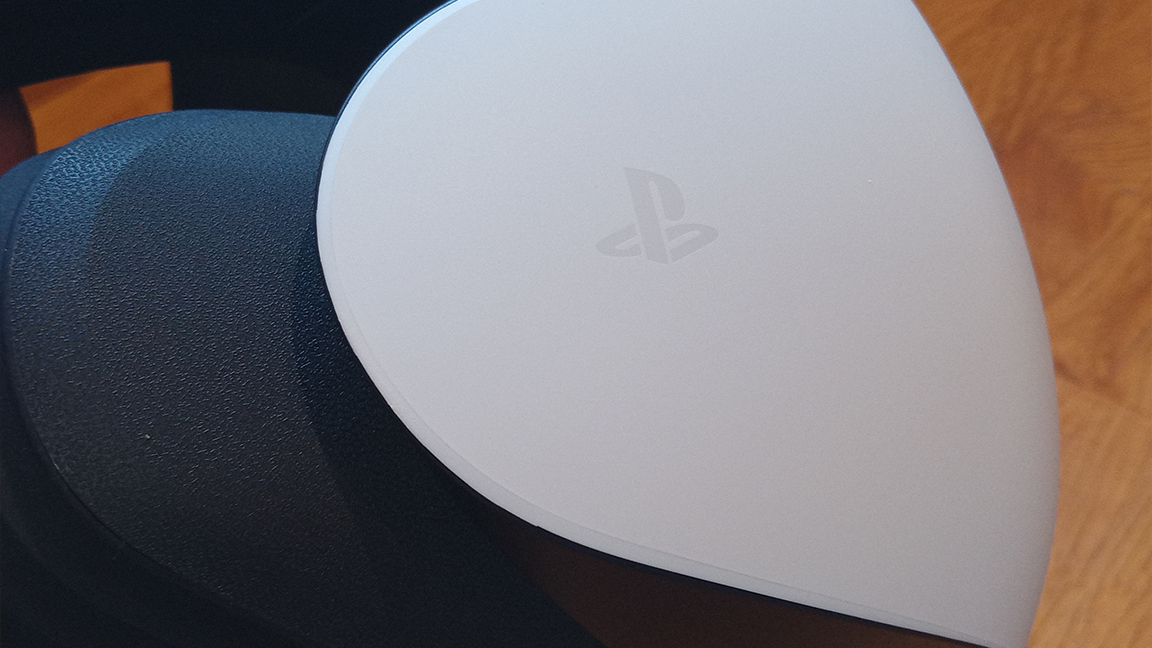
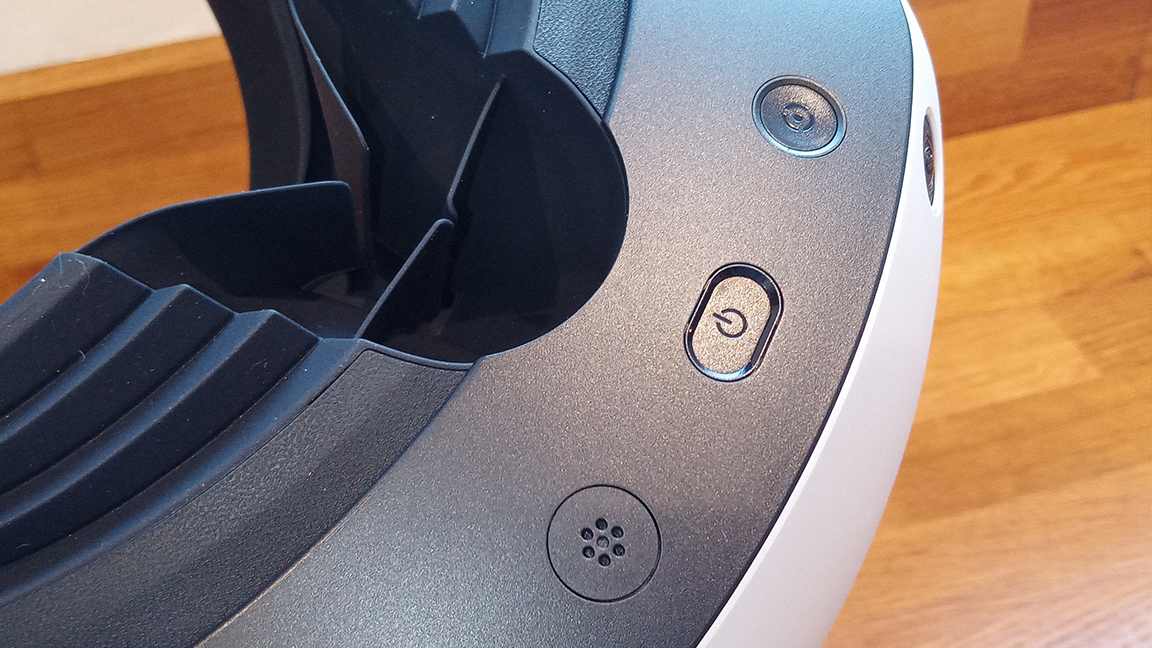
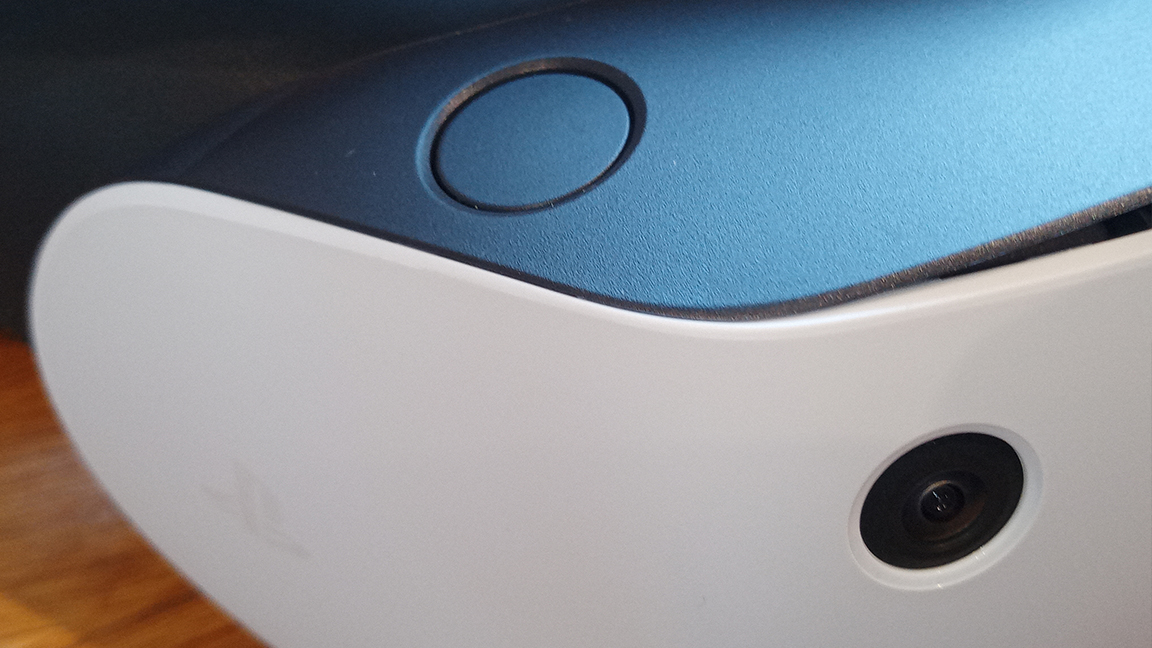
To the rear is the earbud jack (no more clumsy headphone leads) and these clip into the curved band. The headset release and tightening dial are together in one for ease of use. Coming out the back is one lead that connects PSVR 2 to your PS5 using a USB-C lead. This capable is fixed and sits to the left of the head, so left-handed gamers may find it a little awkward but if like me you throw it over your shoulder it's fine. It's a thin-ish standard cable too, meaning it's lighter and easier to handle than some peripherals, and certainly a true next-gen advancement over Sony's first PSVR.
The need for a cable is the only area of design you could criticise and some expected PSVR 2 to be a wireless headset like Meta Quest 2. But this is a far more powerful device anchored to a PS5 than a wireless VR headset, and wired devices deliver better performance and are cheaper, so Sony made a good call here.
On the base of the headset is the power and settings buttons but also something new, there's a button to instantly access PSVR 2's see-through mode to enable spacial adjustment – you can see your surroundings and map yourself to your room. Four cameras on the front of the headset help the hardware know where you can and adjust to your movement – finally, the old PlayStation Camera has been retired.
PSVR 2 review: specs and features
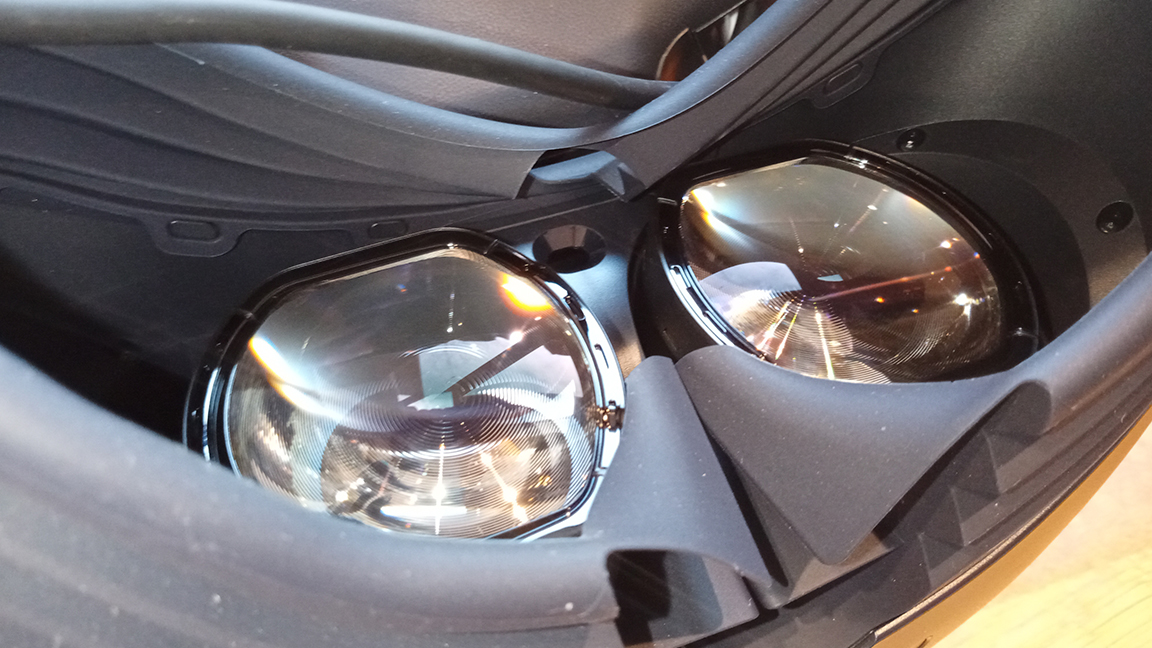
PSVR 2 has an OLED display that reaches 4K resolution by delivering 2000 x 2040 per eye; this is a massive leap over the original PSVR (which tapped out at 1080p) and betters Meta Quest 2 that reaches a 'nearly' 4K resolution (1832×1920 per eye). Sony's PSVR 2 also uses a 90Hz to 120Hz refresh rate, which is ideal for easing VR motion sickness, and combined with its OLED resolution ensures this headset is easier on the stomach than Sony's older model (though I still experienced some uneasiness after two hours of play).
Display: 4K OLED, 2,000 x 2,040 per eye
Refresh rate: 90Hz, 120Hz
Field of view: 110 degrees
Sensors: 6-axis motion sensing system, IR camera, capacitive controller sensors, IR LED position tracking
Feedback: Haptics on controllers and headset
Features: Eye tracking, adaptive triggers, Tempest 3D Audio
Connectivity: USB-C, Bluetooth 5.1
Weight: 19.8oz / 560g
Price: $549.99 / £529.99
Other Requires a PlayStation 5
It's worth noting PSVR 2 uses an OLED display over LED and as such colours can pop more and the worlds you play in generally feel deeper and richer, which is another area Sony's headset betters Meta Quest 2 (which still uses an LED display). The extended 110-degree field of view is a nice addition too, which generally ensures you feel immersed in the virtual reality experiences more than in the older PSVR headset.
Where PSVR 2 really comes into its own is by adopting eye-tracking technology, a first for a consumer-focused VR headset. This means aiming and immersion are improved; for example when playing Horizon Call Of The Mountain eye-tracking subtly enhances the auto-aim meaning I can make accurate shots easily, and when playing multiplayer in Cave Digger 2 you can actually see where other players are looking. Read my Before Your Eyes review to discover how this game makes use of eye tracking in a meaningful way.
The headset also uses eye-tracking to measure interpupillary distance (IPD) and ensure it fits properly and even adjusts if your headset is off slightly (there's a smart setup mode that enables you to align your eyes properly to the lenses). It's this kind of detail that really puts PSVR 2 in a new league of its own, especially for a sub $1,000 / £1,000 VR headset.
One thing that surprised me as I put on the headset and push the power button is the vibration that comes from the PSVR 2. This headset uses haptics to subtly 'rumble' the headset to denote a physical sense of your place in a virtual world. I thought this would be a gimmick but it really works, and even helps with motion sickness – I'm no scientist but the sense of verisimilitude as it vibrates and interacts with the world offers a connection that, I'm sure, convinces my dumb brain I'm actually scrambling up a rock face as a metallic monster gives chase.
PSVR 2 review: audio
So, PSVR 2 doesn't have integrated speakers. Instead you clip in an earbud 'band' into the rear of the headset. Some bemoan this solution as it can lead to them being pulled from your ears and ideally you need to unclip them each time you put away the headset. Personally, I love the solution. Like much of PSVR 2's design this is a neat and simple idea, and certainly feels less clumsy than using bulky headphones.
You can use standard headphones if you'd prefer, and some do. If that's of interest then read our guide to the best wireless headsets and the best headsets for PS5 available now.
The earbuds do perform well, offering good sound quality and even a little noise cancelling, which is ideal for VR immersion. You get Tempest 3D AudioTech in PSVR 2, which is the same as found on PS5's Pulse 3D headphones, and means you can hear sounds around you from all directions. It works, too. I can hear movement from behind, and adjust my position to focus in on the sound.
PSVR 2 review: controllers
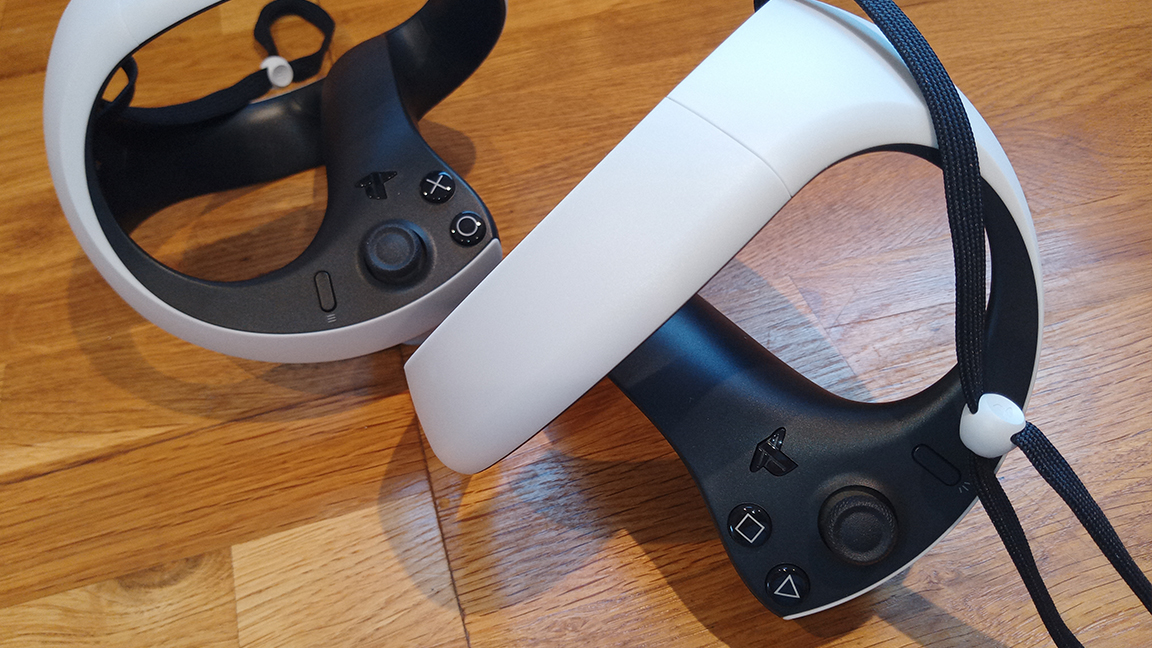
The PlayStation VR2 Sense controllers use inside-out tracking. It's a giant leap over the make-do approach of using the PS3-era PlayStation Move controllers. In my time with the PSVR 2 I tested the tracking out in a mix of lighting conditions, from closing the curtains and playing in the dark to with the lights on; it works really nicely in all conditions (unlike PSVR).
Just as the headset and even the packaging are thoughtfully designed so are these ring-like Sense controllers. While they may look similar in design to the Meta Quest 2 controllers, in practice these are subtly different. For example the sensor rings are positioned over the bottom meaning you can bring your hands together without interference, which is handy for when games demand you hold objects in two hands, reload a gun or clamber up a mountain hand-over-hand. Clever Sony.
When I first held the Sense controllers I found them a little overwhelming – they can be a little button heavy, with sticks, triggers and face buttons everywhere, but in VR it all feels natural, as if the PS5 DualSense has been torn in half. The controllers also make use of capacitive tech so the game you're playing can judge where your hands are and in what position, to represent them realistically in the game. This opens the door for gesture control too, which could be fun in the hands of the right developer.
Special mention goes to the self-tightening controller straps. Place your hand into the strap and tug and it tightens, which is really useful when you have PSVR 2 on your head.
PSVR 2 review: performance

PSVR 2 really is impressive. If this is your first foray into virtual reality then you've come at the right time. If you're a seasoned pro and survived the stomach-churning years of PSVR then your reward is a smooth and immersive one that has mostly dispatched motion sickness.
There are over 40 games to play on PSVR 2 at launch, below are some of the ones I tested. I'll be writing full reviews and testing GT7 and more games very soon.
Horizon Call Of The Mountain
Star Wars: Galaxy's Edge - Enhanced Edition
Moss & Moss Book II
Tetris Effect
REZ Infinite
Song In The Smoke Rekindled
Cave Digger 2 Dig Harder
There's little latency when using PSVR 2 making for an incredibly effortless experience, which means game devs can focus on what really matters and that's selling the world you're inhabiting. In this respect, the use of haptics in the Sense controllers and across the headset is a joy. When passing an object from one hand to the other or grappling to a rock in Horizon Call Of The Mountain, there's a new sense of physicality as the controller vibrates or shudders.
Likewise audio impresses, for example you can hear how different surfaces sound under your feet as you walk and discern noises all around you – which is kind of terrifying when you're playing Resident Evil Village's new free VR mode and I even ducked a number of times in fear of my head coming off my shoulders.
It helps that PSVR 2 uses the power of PS5 to run its games and experiences, ensuring the level of fidelity is constant. This also plays to PSVR 2's strengths, as it feels like a virtual reality PS5 rather than simply a very expensive accessory. PSVR 2 has many of the tech features of PS5 – haptics, 3D audio, fast loading – but applies it in a unique way to virtual reality that feels like an extension of your console.
Now, this is a powerful device and does come with some caveats that you will, or at least I do, expect from VR headsets; namely it's a little heavy to wear for extended times and you can get hot. Even on PSVR 2 most games are designed for short bursts of play, and even those billed as full games, which they are, like Horizon Call Of The Mountain, are divided into bite sized chunks.
I have a rundown of the best PSVR 2 games out now and coming soon to read for more on PSVR 2's launch lineup. There are over 40 games at launch, which ensures Sony's new headset is well supported, many are updates of older PSVR games as well as Meta Quest 2 releases.
PSVR 2 review: verdict
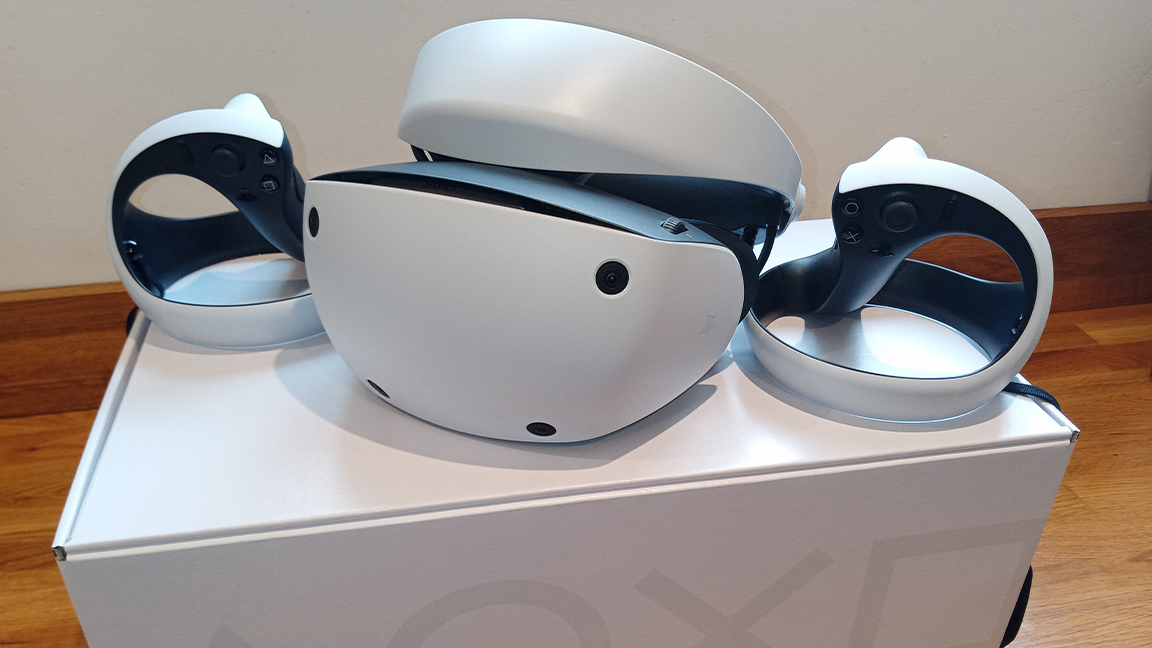
PSVR 2 impresses and is a unique blend of PS5's best features with the leading VR tech in one package. There's a real sense of immersion from being able to place your hand on scenery in a game and feel it through the Sense controller's quite vibration.
I did find motion sickness remains an issue, though this is not as bad as the older PSVR headset but did ensure I restricted play to an hour or two at time. It can depend on the game you play too, and it's worth experimenting with comfort controls to build up your senses (I've not played PSVR in over a year).
Sony has once again come up with an iconic product. This is a perfect marriage of technology and design and is a flawless fit with PS5 while having a personality of its own. Just as importantly care has been taken to ensure PSVR 2 is easy to use, with buttons in exactly the right places and a setup approach second to none.
If you want to take your PS5 gaming further, take a first step into virtual reality, or simply admire a piece of modern technology design, sign yourself up for a PSVR 2.
Read more:
- PS5 vs Xbox Series X: which is best in 2023?

Thank you for reading 5 articles this month* Join now for unlimited access
Enjoy your first month for just £1 / $1 / €1
*Read 5 free articles per month without a subscription

Join now for unlimited access
Try first month for just £1 / $1 / €1
out of 10
PSVR 2 is here and it's, honestly, a fantastic piece of technology. The design riffs on PS5's curves and this hardware design features the kind of approach to detail Sony has become renowned for; the curved lines demand you pick it up. Priced at $549.99 / £529.99, PlayStation VR2 is not cheap, but its worth the investment and represents a true next-gen approach to virtual reality.

Ian Dean is Editor, Digital Arts & 3D at Creative Bloq, and the former editor of many leading magazines. These titles included ImagineFX, 3D World and video game titles Play and Official PlayStation Magazine. Ian launched Xbox magazine X360 and edited PlayStation World. For Creative Bloq, Ian combines his experiences to bring the latest news on digital art, VFX and video games and tech, and in his spare time he doodles in Procreate, ArtRage, and Rebelle while finding time to play Xbox and PS5.

